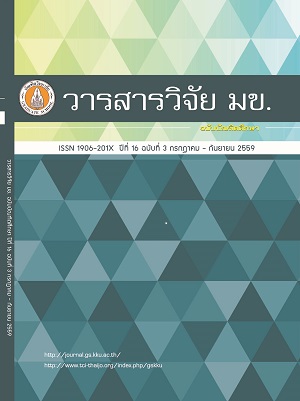การอบแห้งทุเรียนแผ่นด้วยไมโครเวฟร่วมกับลมร้อนโดยใช้เทคนิคการปรับลดระดับกำลังไมโครเวฟ (Durian Chips Drying Using Combined Microwave-Hot Air with Step-Down Microwave Power Input Technique)
Keywords:
การอบแห้งด้วยไมโครเวฟร่วมกับลมร้อน (Combined microwave-hot air drying), ความกรอบ (Crispness), ความแข็ง (Hardness)Abstract
การอบแห้งด้วยไมโครเวฟร่วมกับลมร้อนโดยทั่วไปใช้กำลังไมโครเวฟคงที่ตลอดกระบวนการอบแห้ง การอบแห้งด้วยเทคนิคนี้มีข้อจำกัดคือไม่สามารถใช้ระดับกำลังไมโครเวฟสูงได้ เนื่องจากอุณหภูมิของวัสดุสูง ทำให้ผลิตภัณฑ์ได้รับความเสียหาย ดังนั้นงานวิจัยนี้จึงมีวัตถุประสงค์เพื่อศึกษาการอบแห้งทุเรียนแผ่นด้วยไมโครเวฟร่วมกับลมร้อนโดยใช้เทคนิคปรับลดระดับกำลังไมโครเวฟเปรียบเทียบกับการอบแห้งด้วยลมร้อนในด้านจลนพลศาสตร์ของการอบแห้งทุเรียนแผ่น คุณภาพทางด้านสีและเนื้อสัมผัส รวมทั้งความสิ้นเปลืองพลังงานจำเพาะของกระบวนการอบแห้ง จากผลการศึกษาพบว่า การอบแห้งด้วยไมโครเวฟร่วมกับลมร้อนโดยใช้เทคนิคปรับลดระดับกำลังไมโครเวฟมีอัตราการลดของความชื้นมากกว่าการอบแห้งด้วยลมร้อน ทำให้ใช้เวลาในการอบแห้งสั้นกว่า ในขณะที่การเพิ่มกำลังไมโครเวฟที่ช่วงแรกของกระบวนการอบแห้งทำให้อัตราการอบแห้งเพิ่มขึ้น ทุเรียนแผ่นอบแห้งด้วยไมโครเวฟร่วมกับลมร้อนโดยใช้เทคนิคปรับลดระดับกำลังไมโครเวฟมีค่าความสว่าง ค่าสีเขียว และมีค่าความกรอบมากกว่า แต่มีค่าสีเหลืองและค่าความแข็งต่ำกว่าทุเรียนแผ่นอบแห้งด้วยลมร้อน อย่างไรก็ตามทุเรียนแผ่นอบแห้งด้วยไมโครเวฟร่วมกับลมร้อนโดยใช้เทคนิคปรับลดระดับกำลังไมโครเวฟมีค่าความสว่างมากกว่า แต่ค่าสีเขียว ค่าสีเหลือง และค่าความกรอบต่ำกว่า แต่ค่าความแข็งไม่แตกต่างกันกับทุเรียนแผ่นทอดกรอบจากการค้า การอบแห้งด้วยไมโครเวฟร่วมกับลมร้อนโดยใช้เทคนิคปรับลดระดับกำลังไมโครเวฟมีความสิ้นเปลืองพลังงานจำเพาะต่ำกว่าการอบแห้งด้วยลมร้อน ในขณะที่การเพิ่มกำลังไมโครเวฟในช่วงแรกของการอบแห้งไม่ส่งผลต่อค่าสี ความแข็ง และความกรอบของตัวอย่างอบแห้ง แต่ส่งผลให้ความสิ้นเปลืองพลังงานจำเพาะลดลง นอกจากนี้การอบแห้งทุเรียนแผ่นด้วยไมโครเวฟร่วมกับลมร้อนโดยใช้เทคนิคการปรับลดระดับกำลังไมโครเวฟที่ 800 W เป็นเวลา 1 นาที ตามด้วย 400 W เป็นเวลา 3 นาที แล้วตามด้วย 250 W ร่วมกับลมร้อน 65 oC เป็นเงื่อนไขที่ดีที่สุดสำหรับใช้ผลิตทุเรียนแผ่นอบแห้งไขมันต่ำเพื่อสุขภาพ เนื่องจากให้ความกรอบสูงสุดและมีความสิ้นเปลืองพลังงานจำเพาะต่ำสุด
Combined microwave-hot air drying with constant and continuous-microwave power technique is commonly applied in the drying process. The disadvantage of this technique is product damages due to heat when using high microwave power. Thus, the objective of this work was to study the effect of a combined microwave-hot air (MWHA) with step down microwave power input technique and a hot air (HA) drying technique on the drying kinetic, qualities of dried product in terms of color, texture and specific energy consumption (SEC) of drying process. The results showed that dried durian chips from the step-down MWHA drying technique provided more drying rate than HA drying led to a shorter drying time. Meanwhile, an increase in the microwave power at the first stage of drying process in the step-down MWHA drying also helped increase drying rate. The step-down MWHA drying provided dried products with more lightness, greenness and crispness values but less yellowness and hardness values than the HA drying. The step-down MWHA drying technique also had lower SEC of drying process than HA drying. In addition, dried durian chips from the step-down MWHA were more lightness but less greenness, yellowness and crispness, but no significantly different in hardness when compared with commercial fried durian chips. Meanwhile, increasing in the microwave power at the first stage of step-down MWHA drying had no effect to the qualities in terms of color, hardness and crispness of dried durian chips but resulted in the decreasing of SEC. Moreover, the step-down MWHA at 800 W for 1 min followed by 400 W for 3 min and 250 W combined with hot air at 65 oC was the optimum condition for producing low-fat dried durian chip with the highest crispness and lowest SEC.


